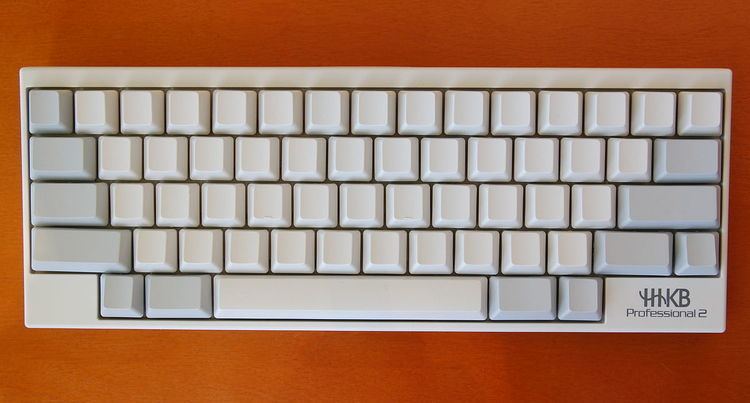Manufacturer PFU Limited Weight 520g | Introduced Dec 20, 1996 | |
 | ||
Part no. PD-KB02/S PD-KB02/PPD-KB02/M Interface PD-KB02/S - SUN Connector PD-KB02/P - PS/2 ConnectorPD-KB02/M - ADB Connector | ||
The Happy Hacking Keyboard is a small computer keyboard produced by PFU Limited of Japan, co-developed with Japanese computer pioneer Eiiti Wada. Its reduction of keys from the common 104 keys layout down to 60 keys in the professional series is the basis for its smaller size while retaining full key size. It returns the control key to its original position as on the early 84 key PC AT and XT layouts. The current models in production are the Happy Hacking Keyboard Professional 2, Professional JP, both either dark or light colors, Type-S silenced variants and blank key caps variants, and the Happy Hacking Keyboard Lite 2 with an additional Macintosh specific variant and a blank variant for each.
Contents
Common features
Some of the Happy Hacking Keyboard design tenets, as dictated by Wada, include a minimal 60 key design, no cursor or function keys, and standard keyboard pitch, all optimized for use in UNIX environments.
Happy Hacking Keyboards lack a numeric keypad, and keys outside the typewriter key area are mainly accessible through the Fn key. The keys are arranged in a layout resembling the Sun Type 3 keyboard. Specifically:
On the far side of the keyboard there are DIP switches. These may be used to:
Its size fits half the size of a DIN A4 paper.
Social status
The keyboard is a status symbol, in part due to price and minimal design, as well as being one of the few currently produced with the left centered control key position. An anniversary edition now discontinued has the distinction of, at the time, being the most expensive keyboard available. Costing about US$5000 with Japanese VAT, the anniversary edition was hand lacquered with 10 coats of Urushi, a traditional toxic tree sap lacquer, and given a sprinkling of gold dust.
